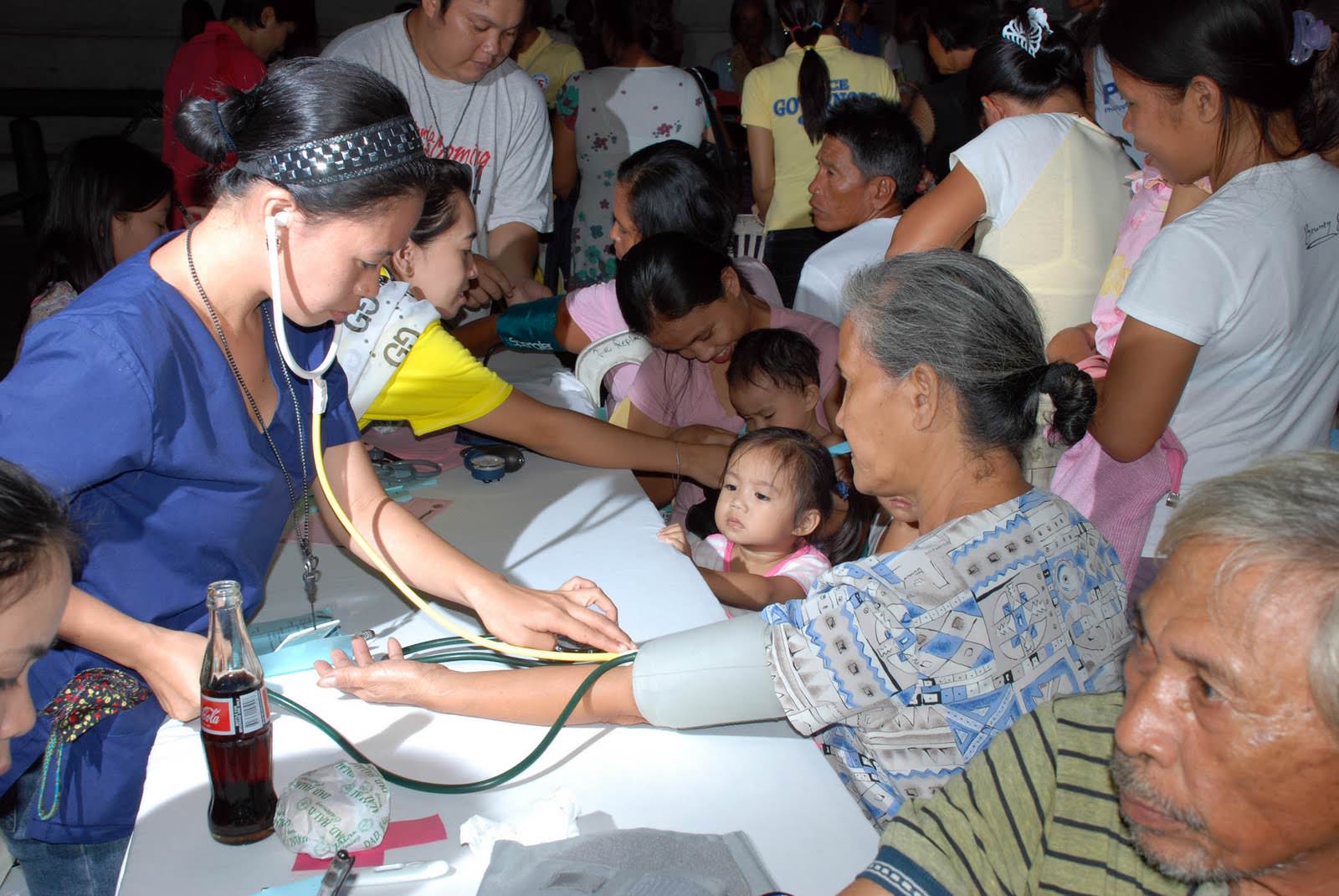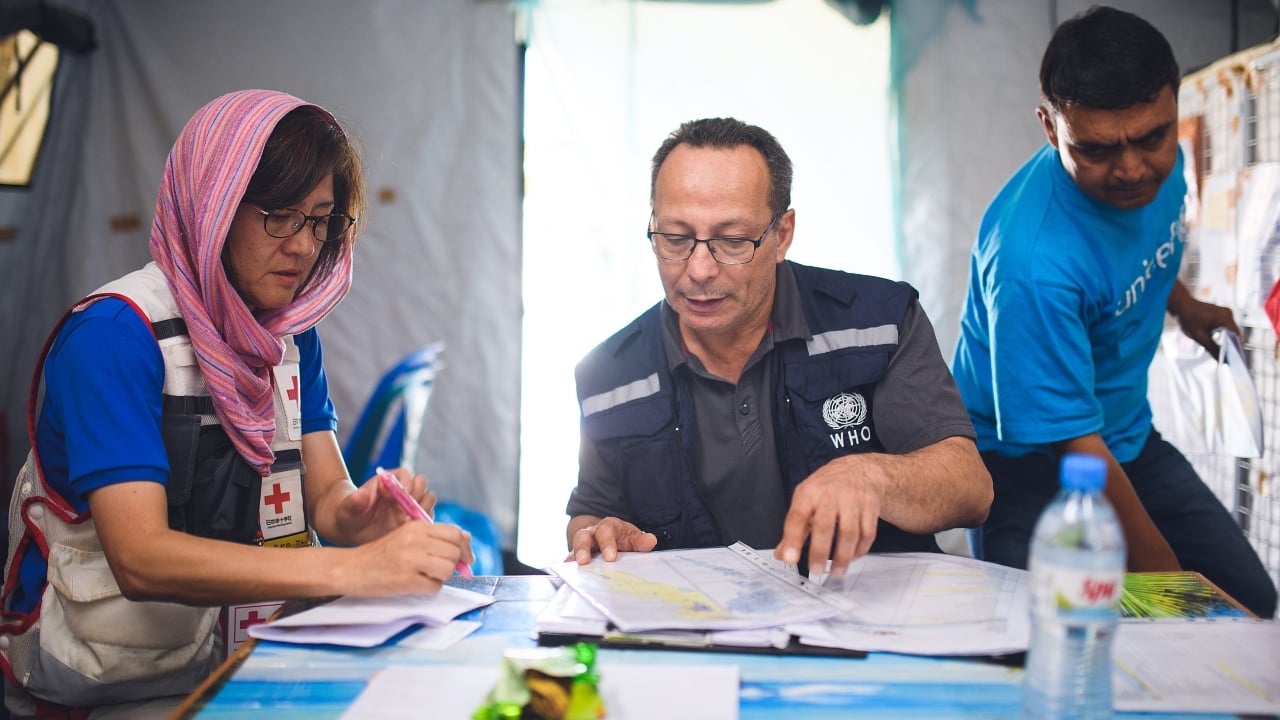Home>Misc>Featured>Which Public Health Policies Help Prevent Communicable Diseases


Featured
Which Public Health Policies Help Prevent Communicable Diseases
Modified: January 2, 2024
Discover the featured public health policies that effectively prevent the spread of communicable diseases, ensuring a healthier community and promoting overall well-being.
Introduction
Public health policies play a crucial role in preventing and controlling the spread of communicable diseases. The rapid transmission of infectious diseases poses a significant threat to global health, highlighting the need for effective strategies to mitigate their impact. In this article, we will explore various public health policies that help prevent communicable diseases and safeguard population health.
Vaccination Programs
A cornerstone of communicable disease prevention, vaccination programs are crucial in reducing the incidence and severity of infectious diseases. Through the administration of vaccines, individuals develop immunity against pathogens, reducing the risk of infection and subsequent transmission. These programs often target high-risk populations, such as infants, the elderly, and individuals with weakened immune systems. By promoting widespread vaccination, public health authorities can achieve herd immunity, protecting vulnerable populations who are unable to receive vaccines due to medical conditions.
Disease Surveillance and Reporting
Timely and accurate disease surveillance systems are essential for detecting outbreaks and enabling rapid response. By monitoring the occurrence and patterns of communicable diseases, public health agencies can identify early warning signs, prevent further transmission, and allocate resources appropriately. Effective surveillance also requires robust reporting mechanisms, where healthcare providers, laboratories, and individuals promptly report suspected cases to the relevant authorities. This information helps track the spread of diseases, identify high-risk areas, and guide targeted interventions.
Quarantine and Isolation Measures
In situations where infectious diseases can spread through close contact, implementing quarantine and isolation measures is crucial to preventing further transmission. Quarantine refers to the restriction of movement and activities for individuals who may have been exposed to a contagious disease but are not yet symptomatic. Isolation, on the other hand, involves separating individuals who are already infected to prevent them from infecting others. These measures are effective in preventing the spread of diseases such as tuberculosis, influenza, and COVID-19.
Health Education and Promotion
Empowering individuals with knowledge about communicable diseases is vital in preventing their transmission. Health education campaigns inform the public about disease symptoms, modes of transmission, and preventive measures. By raising awareness and promoting healthy behaviors, such as hand hygiene, respiratory etiquette, and safe sexual practices, public health officials can empower individuals to protect themselves and others from infectious diseases. These campaigns are particularly effective during disease outbreaks or when introducing new preventive measures, such as mask-wearing during a pandemic.
Vaccination Programs
Vaccination programs are one of the most effective public health interventions in preventing and controlling the spread of communicable diseases. By administering vaccines, individuals develop immunity to specific pathogens, reducing the risk of infection and transmission. Vaccines stimulate the body’s immune system to produce a response that mimics a natural infection without causing the disease itself.
One of the key benefits of vaccination programs is the achievement of herd immunity. When a significant portion of the population is immune to a particular disease, it creates a protective barrier, making it difficult for the pathogen to spread. This is especially important for those who cannot receive vaccines, such as infants or individuals with weakened immune systems. By vaccinating a large proportion of the population, we can protect these vulnerable groups.
Vaccination programs are designed to target specific diseases or groups at higher risk. For example, children are routinely vaccinated against diseases such as measles, mumps, rubella, and whooping cough. The effectiveness of such programs is evident in the significant reduction of these diseases over the years.
In addition to routine childhood immunizations, vaccination programs may also include catch-up campaigns for those who have missed or delayed vaccines. This helps ensure that people of all ages are protected against preventable diseases. Moreover, in situations where outbreaks occur, mass vaccination campaigns can be rapidly implemented to control the spread of the disease.
It is important to note that vaccination programs are backed by extensive research and rigorous testing to ensure safety and efficacy. Vaccines undergo thorough clinical trials before they are approved for use. Regular monitoring and surveillance systems are in place to detect and investigate any potential adverse events following immunization.
Public health authorities also play a crucial role in promoting vaccination programs through education and awareness campaigns. These initiatives address misconceptions and provide accurate information about vaccines, emphasizing their benefits and debunking common myths. By addressing vaccine hesitancy and increasing vaccine acceptance, public health officials can encourage higher vaccination rates, further protecting communities from communicable diseases.
Overall, vaccination programs are essential in preventing communicable diseases. They have successfully controlled and even eradicated diseases such as smallpox and polio. By ensuring high vaccination coverage, we can continue to reduce the burden of infectious diseases and protect public health.
Disease Surveillance and Reporting
Disease surveillance and reporting are crucial components of public health systems that enable the early detection and response to communicable diseases. Surveillance refers to the ongoing monitoring and collection of data on disease occurrence and its characteristics. This information helps public health authorities understand the patterns and trends of diseases, identify outbreaks, and implement targeted interventions.
There are several key elements of effective disease surveillance and reporting:
- Early detection: Surveillance systems are designed to promptly identify potential disease outbreaks or unusual patterns of disease occurrence. This early detection enables rapid response measures and minimizes the spread of the disease. It also allows public health officials to identify risk factors and implement preventive measures.
- Data collection: Surveillance systems collect data from various sources, including healthcare providers, laboratories, and public health agencies. Timely and accurate reporting of suspected cases is crucial for accurate disease tracking. This data provides critical information about the number of cases, demographics, symptoms, and potential risk factors, aiding in the identification and investigation of outbreaks.
- Data analysis and interpretation: Once data is collected, public health officials analyze and interpret the information to detect patterns, trends, and risk factors associated with the disease. This analysis helps understand the spread of the disease, identify high-risk populations or areas, and guide appropriate public health interventions.
- Sharing information: Effective disease surveillance relies on the timely sharing of information among various stakeholders, including local, national, and international health agencies. This facilitates collaboration and coordination in responding to outbreaks and enables the implementation of preventive measures across borders.
- Surveillance technologies: Advancements in technology have greatly enhanced disease surveillance capabilities. Automated reporting systems, electronic medical records, and real-time data sharing enable faster and more accurate disease monitoring. The use of digital tools and geospatial mapping helps visualize disease patterns and guide targeted interventions.
Disease surveillance and reporting systems are essential for tracking the occurrence and spread of communicable diseases, enabling early detection, and guiding public health responses. By promptly identifying outbreaks, public health authorities can implement control measures, such as contact tracing, isolation, and quarantine, to prevent further transmission. These systems also play a crucial role in monitoring the effectiveness of preventive interventions and evaluating the impact of public health policies.
Overall, disease surveillance and reporting are fundamental pillars of public health systems, enabling the proactive identification, response, and control of communicable diseases.
Quarantine and Isolation Measures
Quarantine and isolation measures are essential public health interventions in controlling the spread of communicable diseases, particularly those that can be transmitted through close contact. These measures involve restricting the movement and activities of individuals who may have been exposed to a contagious disease or who are already infected, respectively.
Quarantine is the practice of separating and restricting the movement of individuals who may have been exposed to a communicable disease but are not yet showing symptoms. This preventive measure aims to prevent the spread of the disease during the potential incubation period. Individuals in quarantine are typically advised to stay at home or in designated quarantine facilities and minimize contact with others. Quarantine periods vary depending on the specific disease but usually range from 10 to 14 days.
Isolation, on the other hand, involves separating individuals who are already infected with a communicable disease from those who are not infected. This measure helps prevent further transmission of the disease within the community, healthcare settings, or other confined spaces. Individuals in isolation are typically isolated in healthcare facilities or dedicated isolation centers to receive appropriate medical care and prevent contact with others until they are no longer contagious.
Quarantine and isolation measures are crucial for several reasons:
- Breaking the chain of transmission: By separating individuals who may be infected or are already infected, quarantine and isolation measures interrupt the chain of transmission. This prevents the spread of the disease to others, reducing the overall impact and burden on healthcare systems.
- Protecting vulnerable populations: Quarantine and isolation measures are particularly important in protecting vulnerable populations, such as the elderly, individuals with compromised immune systems, or those with underlying health conditions. By preventing exposure to contagious individuals, we can reduce the risk of severe illness and mortality in these high-risk groups.
- Controlling outbreaks and preventing community spread: Rapid implementation of quarantine and isolation measures is essential in containing disease outbreaks, especially in situations where community transmission has occurred. By isolating infected individuals and quarantining those who may have been exposed, we can limit further transmission and prevent the disease from spreading widely within the community.
- Allowing for timely monitoring and treatment: Quarantine and isolation measures provide healthcare professionals with the opportunity to closely monitor individuals who are potentially infected or already infected. This allows for early detection of symptoms and prompt initiation of treatment, minimizing the severity of the disease and improving patient outcomes.
It is important to note that effective implementation of quarantine and isolation measures requires clear guidelines, adequate resources, and ongoing support for individuals in these situations. Clear communication and public awareness campaigns are essential to ensure understanding of the importance of these measures and to address concerns or misconceptions surrounding quarantine and isolation.
Overall, quarantine and isolation measures are vital tools in controlling the spread of communicable diseases. By promptly implementing these measures, public health authorities can limit the impact of outbreaks and protect the health and well-being of individuals and communities.
Health Education and Promotion
Health education and promotion play a critical role in preventing the spread of communicable diseases. By providing accurate information and promoting healthy behaviors, public health officials can empower individuals to make informed decisions and take proactive measures to protect themselves and others.
Effective health education campaigns focus on several key areas:
- Knowledge about diseases: Health education initiatives aim to raise awareness about communicable diseases, their symptoms, modes of transmission, and preventive measures. By providing accurate and up-to-date information, individuals can better understand the risks and take appropriate actions to protect themselves and their communities.
- Hygiene practices: Promoting good hygiene practices, such as regular handwashing with soap and water, can significantly reduce the transmission of communicable diseases. Health education campaigns emphasize the importance of proper hand hygiene, especially before preparing or consuming food, after using the restroom, or when in contact with potentially contaminated surfaces.
- Respiratory etiquette: Educating individuals about respiratory etiquette, such as covering the mouth and nose with a tissue or elbow when coughing or sneezing, helps prevent the spread of respiratory infections. By practicing respiratory hygiene, individuals can minimize the release of respiratory droplets that carry pathogens.
- Safe sexual practices: Health education also plays a vital role in promoting safe sexual practices to prevent the transmission of sexually transmitted infections (STIs). This includes advocating the use of barrier methods, such as condoms, and promoting regular STI testing and early treatment.
- Immunizations: Health education campaigns help raise awareness about the importance of immunizations in preventing communicable diseases. By addressing misconceptions, providing accurate information, and emphasizing the benefits and safety of vaccines, public health officials can improve vaccine acceptance and uptake.
- Behavioral change: Health education initiatives aim to promote behavioral change by empowering individuals to adopt healthy lifestyles and engage in preventive measures. This can include encouraging regular exercise, maintaining a balanced diet, getting enough sleep, and avoiding risky behaviors that may increase the risk of disease transmission.
Effective health education campaigns should utilize various communication channels to reach diverse populations. This may include traditional media, such as television and radio, as well as digital platforms and social media. Tailoring messages to specific cultural, linguistic, and socioeconomic groups can enhance the effectiveness of health education initiatives.
Furthermore, health education campaigns are especially crucial during disease outbreaks or when introducing new preventive measures. By addressing public concerns, dispelling myths, and providing clear instructions, public health officials can foster trust and cooperation within communities.
Collaborating with healthcare providers, community organizations, and schools is also essential in promoting health education. These partnerships can facilitate the dissemination of information and provide opportunities for interactive educational activities, workshops, and training sessions.
Overall, health education and promotion are vital components of communicable disease prevention. By empowering individuals with the knowledge and skills to protect their health, we can collectively work towards reducing the transmission and impact of communicable diseases.
Access to Healthcare Services
Ensuring access to healthcare services is a crucial aspect of preventing and controlling communicable diseases. Accessible and affordable healthcare services play a vital role in disease detection, treatment, and prevention, particularly for vulnerable populations. Without proper access, individuals may delay seeking care, leading to the potential spread of infectious diseases in the community.
Here are some key factors that contribute to access to healthcare services:
- Geographical accessibility: Physical proximity to healthcare facilities is essential to ensure timely access to services. The availability of clinics, hospitals, and primary care centers in both urban and rural areas helps individuals seek appropriate care and preventive measures when needed.
- Financial affordability: Access to healthcare services can be hindered by financial barriers. High healthcare costs, including consultation fees, medication, and diagnostic tests, may deter individuals from seeking care. Implementing affordable healthcare financing models, such as universal healthcare systems or health insurance schemes, can help mitigate these barriers.
- Language and cultural competence: Language barriers and cultural differences can act as obstacles to healthcare access. Ensuring that healthcare providers can communicate effectively with diverse populations and respect cultural practices and beliefs is essential in providing equitable care to all individuals.
- Health literacy: Adequate health literacy is vital for individuals to understand and navigate the healthcare system. Public health education programs that focus on improving health literacy can empower individuals to make informed decisions about their health and seek appropriate care.
- Comprehensive services: Access to a full range of healthcare services, including preventive care, diagnostics, treatment, and follow-up care, is essential in preventing and managing communicable diseases. This includes immunizations, screening programs, and access to medications and therapies.
- Epidemic preparedness: Healthcare systems need to be prepared to respond to outbreaks and emergencies. This includes having surge capacity in healthcare facilities, ensuring an adequate supply of medical equipment and medications, and establishing emergency response protocols.
- Community engagement: Engaging communities and involving them in healthcare decision-making processes can improve access to services. This can be achieved through community mobilization, awareness campaigns, and partnerships with local organizations to ensure that healthcare services are tailored to the specific needs of the community.
Without equitable access to healthcare services, individuals may face barriers in receiving timely diagnosis, treatment, and preventive measures. This can result in increased morbidity and mortality rates and the continued transmission of communicable diseases within the population.
Addressing barriers to healthcare access is crucial for achieving equitable health outcomes and reducing the burden of communicable diseases. Efforts should be made to promote universal access to healthcare services, eliminate financial barriers, improve health literacy, and foster culturally sensitive care.
By ensuring equitable access to healthcare services, we can enhance disease prevention, early detection, and control efforts, leading to improved overall population health.
Vector Control Measures
Vector control measures are crucial in preventing and managing communicable diseases that are transmitted by vectors, such as mosquitoes, ticks, flies, and fleas. These disease-carrying vectors play a significant role in the transmission of diseases like malaria, dengue fever, Zika virus, and Lyme disease. Implementing effective vector control measures is essential to reduce vector populations, minimize human-vector contact, and prevent the spread of these diseases.
Here are some key vector control measures:
- Environmental management: Modifying and managing the environment to eliminate breeding sites and reduce vector populations is an important vector control strategy. This may include removing stagnant water sources, maintaining proper garbage disposal practices, and improving sanitation to reduce the breeding grounds for mosquitoes and other vectors.
- Insecticide-treated bed nets: In regions where mosquitoes are a significant vector for diseases like malaria, the use of insecticide-treated bed nets is crucial. These bed nets provide a physical barrier and are treated with insecticides that repel or kill mosquitoes, reducing the risk of bites and subsequent disease transmission.
- Indoor residual spraying: Indoor residual spraying involves the application of insecticides to the interior surfaces of houses and dwellings. This control measure targets resting mosquitoes and other vectors, reducing their populations and preventing them from transmitting diseases to humans. The use of safe and effective insecticides is important to minimize environmental and health risks.
- Personal protective measures: Individuals can protect themselves from vector-borne diseases by taking personal protective measures. This includes wearing protective clothing, using insect repellents, and avoiding outdoor activities during peak vector activity times, such as dawn and dusk.
- Vector surveillance and control programs: Effective vector control programs require ongoing surveillance to monitor vector populations and disease transmission levels. This enables early detection of outbreaks and targeted vector control interventions. Integrated vector management approaches, combining multiple control methods, are often employed to maximize effectiveness.
- Vector-borne disease awareness and education: Raising awareness about vector-borne diseases and methods of prevention is crucial in communities at risk. Health education campaigns can help individuals understand the risks associated with vectors and empower them to take appropriate preventive measures.
- Research and innovation: Continued research and innovation in vector control methods are essential to develop new tools and strategies. This includes the development of new insecticides, vector control technologies, and vector control measures that are safe, effective, and sustainable.
Implementing comprehensive vector control measures requires a multi-sectoral approach involving public health authorities, environmental agencies, and communities. Collaboration and coordination are key in designing and implementing effective vector control strategies that are tailored to the specific needs and challenges of each region.
Vector control measures have proven to be effective in reducing the burden of vector-borne diseases worldwide. By targeting vectors at different stages of their lifecycle and decreasing human-vector contact, we can significantly reduce the transmission of communicable diseases and improve public health.
Water and Sanitation Improvements
Improvements in water and sanitation infrastructure are fundamental in preventing the spread of communicable diseases, particularly those transmitted through contaminated water sources or poor sanitation practices. Access to safe drinking water and proper sanitation facilities is essential in reducing the risk of water-borne diseases and improving overall public health.
Here are some key aspects of water and sanitation improvements:
- Safe drinking water: Ensuring access to safe drinking water is crucial in preventing water-borne diseases. This involves implementing measures to treat and disinfect water sources, such as using filtration systems, chlorination, or other appropriate water treatment methods. Regular monitoring of water quality is necessary to ensure its safety for consumption.
- Improved sanitation facilities: Access to improved sanitation facilities, including proper toilets and wastewater management systems, is essential in preventing the transmission of diseases that can occur through contact with human waste. Adequate sanitation facilities help prevent the contamination of water sources and the spread of fecal-oral diseases, such as cholera and hepatitis A.
- Hygiene promotion: Promoting good hygiene practices, such as handwashing with clean water and soap, is crucial in reducing the transmission of communicable diseases. Awareness campaigns and education on proper hygiene practices can help individuals understand the importance of hand hygiene, food safety, and personal cleanliness.
- Community engagement: Engaging communities in water and sanitation improvement efforts is vital for sustainable change. Involving community members in the planning, implementation, and maintenance of water and sanitation infrastructure fosters ownership and ensures that facilities are tailored to the specific needs and cultural contexts of the community.
- Proper waste management: Establishing effective waste management systems that include proper collection, disposal, and recycling of waste is crucial in preventing environmental contamination and the spread of diseases. This includes both solid waste management and the safe disposal of hazardous waste.
- Monitoring and regulatory frameworks: Regular monitoring of water quality, sanitation practices, and compliance with standards is necessary to ensure the effectiveness and safety of water and sanitation improvements. Establishing regulatory frameworks and enforcing adherence to standards promotes accountability and helps maintain the quality of water and sanitation services.
- Equitable access: Ensuring equitable access to safe water and sanitation facilities is essential for achieving public health goals. This involves addressing disparities in access, particularly among marginalized populations and in underserved areas, to ensure that everyone has equal opportunities to benefit from water and sanitation improvements.
Water and sanitation improvements have significant impacts on public health, reducing the burden of water-borne diseases and improving overall well-being. Access to safe drinking water, improved sanitation facilities, and proper hygiene practices contribute to the prevention of communicable diseases and the promotion of healthy communities.
Collaboration between various stakeholders, including governments, public health authorities, community organizations, and international partners, is necessary to implement effective water and sanitation interventions and address the underlying challenges that limit access to these essential services.
Food Safety Regulations
Food safety regulations are essential in preventing the transmission of communicable diseases through contaminated food. Ensuring that food is safe and free from harmful pathogens, chemicals, and contaminants is crucial to protect public health and prevent foodborne illnesses.
Here are some key aspects of food safety regulations:
- Food handling and storage: Regulations often include guidelines for safe food handling practices, including proper storage, preparation, cooking temperatures, and hygiene practices for those involved in the food industry. This helps prevent the growth and spread of bacteria, viruses, and other pathogens that can cause foodborne illnesses.
- Food labeling and traceability: Regulations require clear and accurate labeling on food products, including information about allergens, nutritional content, expiration dates, and country of origin. This ensures that consumers can make informed choices and helps trace and recall potentially contaminated food items in the event of an outbreak or safety concern.
- Inspection and monitoring: Regulatory bodies conduct regular inspections of food establishments, farms, and processing plants to ensure compliance with safety standards. This involves monitoring processes, facilities, equipment, and employee practices to identify and address potential hazards and maintain food safety standards.
- Hazard analysis and critical control points (HACCP): HACCP is a preventive approach to food safety that identifies potential hazards in the food production process and establishes critical control points to prevent, eliminate, or reduce these hazards to acceptable levels. It requires food businesses to develop and implement a systematic approach to ensure food safety at each stage of production, processing, and distribution.
- Import and export regulations: Regulations often govern the import and export of food products to ensure compliance with safety standards. This includes inspections, certifications, and adherence to international food safety agreements or regulations.
- Rapid response systems: Establishing rapid response systems is crucial to detect and respond promptly to foodborne illness outbreaks. This involves coordination between health departments, regulatory agencies, and the food industry to investigate outbreaks, trace the source of contamination, and implement appropriate control measures.
- Consumer education: Educating consumers about safe food handling practices, proper food storage, and the importance of purchasing from reputable sources is essential in preventing foodborne illnesses. Public health campaigns help raise awareness and empower individuals to make informed choices about food safety.
Effective food safety regulations require collaboration between government agencies, food producers, retailers, and consumers. Ensuring compliance with regulations through inspections, monitoring, and enforcement promotes accountability and protects public health.
International cooperation is also crucial in establishing consistent food safety standards and harmonizing regulations to facilitate safe food trade across borders. Organizations such as the World Health Organization (WHO) and the Food and Agriculture Organization (FAO) work to develop and disseminate guidelines and promote best practices in food safety worldwide.
Overall, food safety regulations play a fundamental role in safeguarding public health by reducing the risk of foodborne illnesses. By implementing and enforcing these regulations, we can ensure that the food we consume is safe, protecting individuals and communities from the transmission of communicable diseases through contaminated food.
Travel Restrictions
Travel restrictions are measures implemented by governments and public health authorities to control the spread of communicable diseases across national and international borders. These restrictions aim to minimize the importation and exportation of infectious diseases by regulating the movement of people, particularly in times of disease outbreaks or public health emergencies.
Here are key aspects of travel restrictions:
- Border control measures: Governments may implement entry and exit screening procedures, such as health questionnaires, temperature checks, and testing, to identify individuals who may be infected with a communicable disease. This helps prevent the entry of infected individuals into a country and the potential spread of the disease within the community.
- Travel advisories and warnings: Public health agencies issue travel advisories and warnings to inform the public about the risks associated with traveling to specific destinations. These advisories may recommend avoiding non-essential travel to areas experiencing disease outbreaks or high levels of disease transmission.
- Quarantine requirements: Some countries may mandate quarantine or isolation measures for travelers arriving from high-risk areas. This can include self-quarantine at home or designated quarantine facilities for a specified period to monitor for any potential symptoms and reduce the risk of transmission.
- Travel bans and limitations: In certain situations, governments may impose travel bans or limitations on specific regions or entire countries to restrict the movement of people and prevent the spread of a communicable disease. These measures can include restrictions on inbound and outbound flights, cruise ship operations, or land border crossings.
- Health declarations and documentation: Travelers may be required to provide health declarations or documentation, such as proof of vaccination or negative COVID-19 test results, before entering a country. This helps ensure that individuals traveling internationally are not carrying and potentially transmitting communicable diseases.
- Collaboration and coordination: International cooperation and coordination are essential in managing travel restrictions effectively. Countries and global health organizations work together to share information and align restrictions to prevent the importation and spread of communicable diseases across borders.
- Monitoring and adjusting measures: The implementation of travel restrictions requires ongoing monitoring and assessment of the disease situation. Public health authorities regularly evaluate the effectiveness of travel restrictions and adjust measures as needed based on the evolving risks and transmission patterns of communicable diseases.
It is important to note that while travel restrictions can be effective in controlling the spread of diseases, they can also have significant social, economic, and political implications. Governments must carefully consider the potential consequences and balance public health needs with the impacts on international trade, tourism, and individual rights.
Transparent communication, timely dissemination of information, and clear guidelines are crucial in ensuring that travelers understand the restrictions and comply with the necessary measures. The cooperation of both travelers and transportation providers is essential in adhering to and enforcing travel restrictions.
Travel restrictions serve as an integral part of a comprehensive strategy to manage communicable diseases. By implementing these measures, governments can minimize the risk of importing and exporting infectious diseases and protect the health and well-being of their populations.
Conclusion
Public health policies and measures to prevent communicable diseases are critical in safeguarding population health. From vaccination programs to vector control measures, water and sanitation improvements, and travel restrictions, a comprehensive approach is necessary to minimize the transmission and impact of infectious diseases.
Vaccination programs are highly effective in reducing disease incidence and severity. By promoting widespread vaccination, public health authorities can achieve herd immunity and protect vulnerable populations. Disease surveillance and reporting help detect outbreaks early and guide targeted interventions, while quarantine and isolation measures prevent further transmission of infectious diseases. Health education and promotion empower individuals with knowledge and promote healthy behaviors, contributing to disease prevention. Access to healthcare services ensures timely diagnosis, treatment, and preventive measures for all individuals.
Vector control measures help reduce the populations of disease-carrying vectors and minimize human-vector contact. Water and sanitation improvements prevent water-borne diseases and promote overall public health. Strict food safety regulations help prevent foodborne illnesses and protect individuals from contamination. Travel restrictions, when implemented appropriately, help control the spread of communicable diseases across borders.
It is important for governments, public health authorities, healthcare providers, communities, and individuals to work together in implementing and adhering to these policies and measures. This requires collaboration, coordination, and a commitment to ensuring equitable access to healthcare, education, and resources.
As the global population continues to face the challenges of emerging infectious diseases, the importance of effective and comprehensive public health measures cannot be overstated. Continued research, innovative technologies, and ongoing surveillance are crucial in staying ahead of evolving infectious diseases and protecting public health.
By implementing and prioritizing these public health policies and measures, we can mitigate the risks of communicable diseases, improve global health outcomes, and create a safer and healthier future for all.









